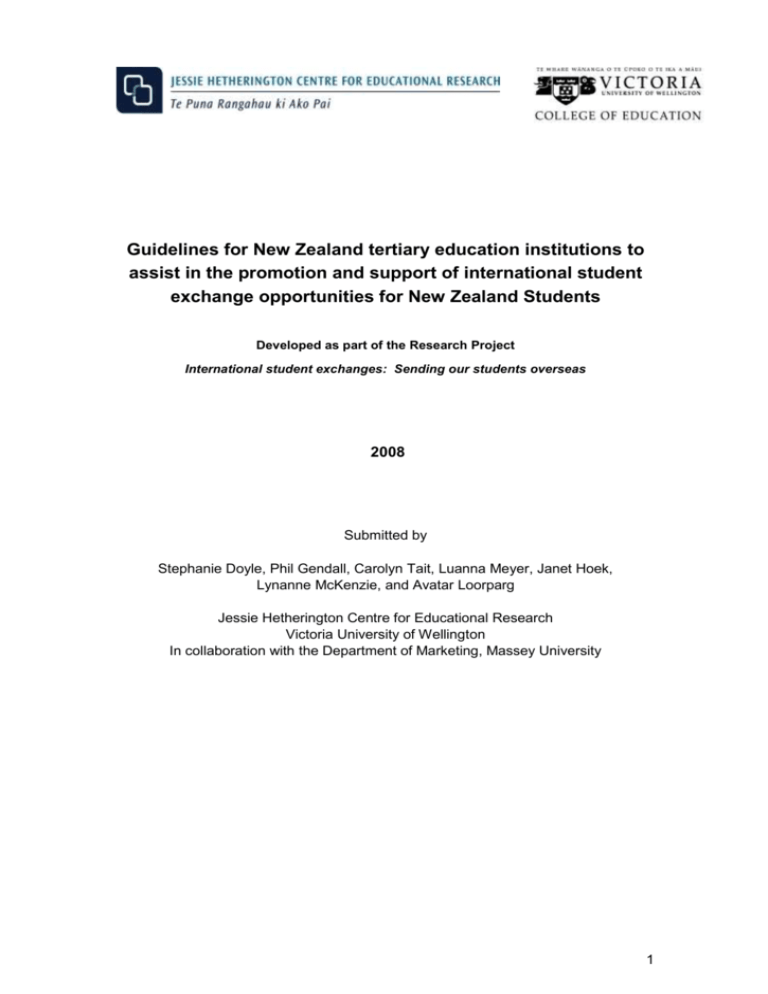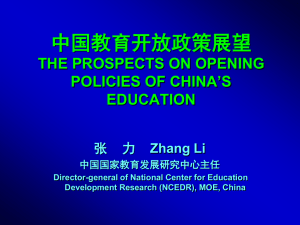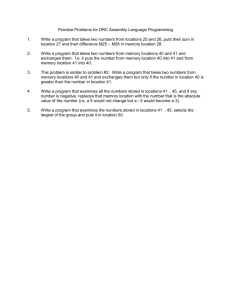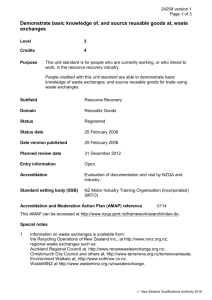42159_International_Student_Exchanges_Guidelines_0
advertisement

Guidelines for New Zealand tertiary education institutions to assist in the promotion and support of international student exchange opportunities for New Zealand Students Developed as part of the Research Project International student exchanges: Sending our students overseas 2008 Submitted by Stephanie Doyle, Phil Gendall, Carolyn Tait, Luanna Meyer, Janet Hoek, Lynanne McKenzie, and Avatar Loorparg Jessie Hetherington Centre for Educational Research Victoria University of Wellington In collaboration with the Department of Marketing, Massey University 1 Acknowledgements These guidelines are based on research undertaken by the Jessie Hetherington Centre for Educational Research in collaboration with the Department of Marketing in the College of Business at Massey University. The research team is grateful to the four universities, one institute of technology polytechnic (ITP) and the many staff and students who participated in interviews, focus groups and surveys, and who provided documentation on their internationalization and exchange activities. The guidelines presented here address gaps identified by participants and are based on exemplary practices shared with the research team. As this work would not have been possible without this input, we wish to extend our appreciation to the research participants who gave their time and made numerous thoughtful contributions We acknowledge the assistance and support provided by the Ministry of Education, in particular that provided by Dama Black, Sushrutha Metikurke and Paul Lister. Other support for the research project was provided by the administration and computing consultant staff of the Jessie Hetherington Centre and from the Department of Marketing at Massey University. Stephanie Doyle Phil Gendall Carolyn Tait Luanna Meyer Janet Hoek Lynanne McKenzie Avatar Loorparg 5 December 2007 2 Introduction The guidelines presented here are based on research undertaken by the Jessie Hetherington Centre for Educational Research, Victoria University. The multidisciplinary team included researchers from Victoria University and the Department of Marketing, Massey University. The Ministry of Education contracted the team to find out what contributes to the low level of participation of New Zealand tertiary students in student exchanges and what might be done to address this. This project is part of the Ministry’s work programme on the implementation of the Tertiary Education Strategy 2002-2007, specifically Strengthening System Capability and Quality, and it connects to the national goal of Building Global Linkages. A brief summary of the research is provided here, drawn from the full research report presented to the Ministry of Education. The assumption is that readers of the Guidelines will not necessarily read the full report but will want to know the context and rationale for the suggestions. The research included a review of trends and practices in selected countries such as Australia, Canada, the United Kingdom and the United States. Attention was paid to the implications of the Bologna Process for student exchanges. Five tertiary education institutions (TEIs), four universities and one institute of technology polytechnic (ITP) participated in case studies. Students from four of the five TEIs were surveyed on their perceptions and experiences of student exchanges. Student exchanges are one of the major vehicles for student mobility and involve formal agreements between institutions to enable students to study at partner institutions while paying domestic fees. Partnerships for the exchange of students may be stand-alone or part of a wider agreement to collaborate in teaching and research. They may be on an institution to institution basis, or organized as part of a consortium of like institutions. An agreement will specify the maximum number of students able to move each way, and reciprocity is valued. However, New Zealand has greater numbers of inbound international students than outbound. All New Zealand universities and most ITPs have agreements for student exchange. The case study TEIs all had a number of agreements, some of which were inactive. Review processes have been implemented in all the TEIs to ensure that inactive and inappropriate agreements are retired and to clarify the status of other agreements. There is a growing awareness of the need to align student exchange agreements with wider academic and institutional goals and projects. The evidence from the research suggests that strategic consortia with like institutions, e.g., Universitas 21 (U21) or within a discipline, e.g., Partnership in International Management (PIM) may be helpful for internationalising the university or ITP and easing student exchange arrangements. New Zealand TEIs have made limited moves to internationalise the student experience. Whereas in the U.S. and Europe foreign language study and/or study abroad may be built into undergraduate degree programmes, this is rare in New Zealand. Significant work is underway at institutional levels in North America, Europe, and Australia to make student exchanges and other forms of international experience an integral component of the undergraduate experience. For example, in 3 the U.S. bold targets have been set for participation and for expanding the profile of participants and of destination regions. In Europe, study abroad, and in particular the ERASMUS exchange system, is standard in the undergraduate experience. By 2010, the Bologna Process will see structures and systems in place to enable ease of student mobility across Europe. The situation calls for careful and considered planning and resourcing if New Zealand TEIs are to stay abreast of international developments and position their institutions to participate in a more internationally connected world. Findings from the research that are relevant to the support and promotion of student exchanges included the following: All five TEIs had allocated resources and staffing to support outbound student exchanges and saw this as crucial for maintaining and developing a viable exchange programme. The participating TEIs all provided comprehensive information about exchanges, partners, loans and allowances, and other aspects of exchanges. Typically, accessing this information required prior interest and initiative by a student, such as visiting the exchange office or website. There was little awareness among staff or students that student exchange arrangements involved payment of domestic fees rather than paying the fees of the host institution overseas. In general, students lacked knowledge about exchanges, including eligibility for exchanges, possible destinations, available grants and scholarships, and processes for maintaining eligibility for loans and allowances. Most students were not fluent in any language other than English or Māori, thus had limited capability for study or interest in non-English speaking destination universities and countries. There was a lack of awareness that university courses may be taught in English at many non-English speaking institutions and that some universities in non-English speaking countries deliver all tuition in English. The process of planning and organising an exchange can be demanding for students alongside their usual academic workloads, particularly in their first year of a degree when they are mastering the transition to university. Limited assistance is available to students for contacting institutions, embassies, and in organising finances and accommodation. Most academic staff and departments have limited experience with, and knowledge, about student exchanges. Successful exchange agreements often involve academic staff championing the exchange within their faculty. 4 The Ministry asked the research team to develop a set of guidelines for tertiary institutions to assist in the promotion and support of student exchanges. The guidelines are divided into four sections: Section one: Institution level Institutional policy and leadership Academic policy and programmes Conjoint and other partnership programmes. Section two: Promotion Promotion of student exchanges to prospective students Promotion of student exchanges to current students Academic staff and the promotion of student exchanges. Section three: Support Support for New Zealand students planning an exchange Support for New Zealand students on exchange Support for New Zealand students returning from overseas exchange. Section four: Considerations for the national and inter-institutional level 5 Section one: Institution level Institutional policy and leadership 1. Develop and articulate a clear vision of what the institution seeks to achieve in terms of internationalisation. For some, this may include graduates having knowledge of international perspectives, while for others it may include graduates who have the competencies and attributes to live and work in international settings. For example, one of eleven guiding principles to the international policy of one Australian University is: Monash University will incorporate international and intercultural perspectives and inclusive pedagogy into its courses in order to prepare students to perform capably, ethically and sensitively in international and multicultural professional and social contexts (www.policy.monash.edu/policy-bank/academic/education/management/internationalisation, 2005, p.3) 2. Increase commitment and awareness of the need to internationalise the curriculum, the student experience and the university/ITP. A report from a strategic taskforce on study abroad in the U.S. quoted the leader of Michigan State University as saying: We have absolutely made an institutional commitment to make study abroad available to all students, in all our undergraduate programs, at a cost no greater than they would pay by remaining on campus for a semester. This is a major institutional undertaking, particularly for one of our size and mission complexity, but we believe that it is essential if we are to graduate educated students. (Strategic Taskforce on Education Abroad, 2003, p.13) 3. Ensure that academic staff and leaders in the institution are knowledgeable regarding global trends and developments in relation to internationalising undergraduate education. This might involve providing seminars and print/web information on developments such as the Bologna Process, The European Credit Transfer System (ECTS), and the Degree Supplement. 4. Develop policy and strategies for broadening the profile of students participating in international experience to reflect the demographic and academic profile of the institution. Ensure there are feasible and attractive options for all students regardless of discipline, including students who may: 6 be part-time (in full-time employment; those with dependents) have disabilities have limited financial support be first generation students in tertiary education lack exposure to overseas study or experience be Māori show interest in indigenous law, language, culture, and peoples strive to develop a second or third language. 5. Set measurable targets for increasing participation rates of undergraduate students and of the groups identified above for: year-long exchanges semester-long exchanges short courses or group tours other international experiences partner institutions or regions. 6. Create incentives at faculty and individual academic staff level for involvement in operationalising and supporting internationalisation policies including student exchanges. 7. Conduct an annual review of progress in internationalisation, including undergraduate exchanges and academic staff engagement with partner institutions in collegial activities including research and teaching. Academic policy and programme 8. Routinely address internationalisation implications programme approval processes by considering: within academic an option of study abroad/exchange a second language alignment of programmes with partner institutions alignment with Bologna/European Higher Education Area (EHEA) or similar outcomes or attributes such as developing an international perspective, or competence to work in other regions. 9. Establish academic structures that provide all students with the option to study a language other than English and/or include a study abroad experience in their degree studies. 10. Include language and international studies as requirements for majors with an international dimension such as international business. 11. Develop programmes that enable credit for international experience at the end of a degree such as: 7 Business with a year in Asia (see University of York’s degrees with a year in Europe or a year in Industry) graduate diplomas, equivalent to one year’s full-time study, which includes a structured overseas learning experience such as: service learning in a non-English speaking country study at a non-English speaking overseas institution internship language study. For example, Otago University offers a Graduate Diploma compatible with student exchange and also offers students the option of studying for a Diploma in Language, or in Language and Culture, alongside their degree studies. 12. Internationalise the curriculum by ensuring that appropriate programmes have international as well as local content and importantly include international experience as a component. 13. Building options into degrees such as service learning (volunteers), internships, placements, study abroad, and exchanges. Conjoint and other partnership programmes 14. Establish parallel programmes offered conjointly with overseas partners that require going overseas for a component of the programme. An example is the U21 Certificate in Global Issues offered by the Universities of Auckland, Hong Kong, Melbourne, Nottingham and British Columbia, designed for undergraduates to complete alongside their degree studies. This programme requires at least half of the Certificate to be completed through a partner university either online or by going overseas. 15. Establish models such as the University of Technology Sydney’s combined degrees with international studies. This programme requires at least two semesters at a non-English speaking campus and a foreign language. It lends itself to a range of disciplines, exchanges and to self-funded study abroad. 8 Section two: Promotion Promotion of student exchanges to prospective students 16. Ensure that liaison staff who work with schools are knowledgeable about the TEI’s vision for internationalisation and of how international experience may benefit students. Liaison staff must have specific knowledge of potential destinations and institutional partners, and information regarding available financial support such as the New Zealand Undergraduate Study Abroad Awards. 17. Sow the seeds for student exchanges in the initial recruitment process. For example, Massey University in its website information for prospective students has a question “Where can I study?” and provides a bullet point list of its campuses and student exchange (www.massey.ac.nz). 18. Include student exchanges as a standard component in information for schools, prospective students, parents and career advisors. Prospectuses, websites, career expos, campus visits, and school careers evenings and similar should be expected to include information on international experience and on student exchange opportunities. Effective information is included on the Auckland University website for prospective students (www.auckland.ac.nz). Encourage all students to consider an exchange as a great opportunity to get international experience and tell them that they: will maintain eligibility for loans and allowances may be eligible for grants and scholarships will pay domestic fees only, so they may be able to study at a prestigious Asian, North American or European university and pay New Zealand domestic fees have the option of courses in English in some non-English speaking countries should look at diverse destinations will not be required to take any longer to complete their studies. 19. Provide information for parents on student exchanges and study abroad as a standard component in parents’ weblinks and guidebooks. This would include potential benefits of exchange, partner institutions, and information on grants and scholarships. 20. Include reply-paid postcards with enrolment information to enable students to request information on student exchange opportunities and funding available. Promotion of student exchanges to current students Websites and other information sources provided for current students, in particular for first year students, should include information on exchanges. 21. Publicise exchange and other study abroad initiatives using the campus and student media. Invite outbound students to contribute. Maintain blogs of 9 students’ experiences while away, perhaps have a “postcards from abroad” section on Blackboard. Ensure that these blogs go beyond social and travelogue type information to include information on the academic and professional benefits of study abroad. 22. Include specific information in faculty and school programme guides and outlines regarding overseas partners and courses relevant to the discipline and how students can learn more about student exchanges. Exchange offices should provide assistance and support to academic areas to develop appropriate material. Faculty and school homepages should have a clearly identifiable web-link leading directly to information about disciplinary and professional academic study abroad opportunities in specific programmes. 23. Hold discipline-specific evenings to promote student exchange opportunities, and where possible involve inbound international students and returned outbound students. Academic staff and promotion of student exchanges 24. Include information on internationalization and student exchange opportunities in induction programmes for academic staff. Provide simple, clear information for academic staff on funding available for students towards study at partner institutions. Induction packs for staff could include information on the New Zealand Study Abroad Awards (NZSAA) grants and other funding plus information on linkages with partner institutions or consortia. Help academic staff to be knowledgeable about possibilities for staff and students in their discipline in terms of teaching and research overseas. 25. Encourage collegial interactions between academic staff in partner higher education institutions, including support for, and promotion of, teaching and research exchanges. 26. Require that academic units gather systematic feedback on exchange advice, support and experiences from students and staff both prior to and after student exchanges. 10 Section three: Support for students for exchanges Support for New Zealand students planning an exchange 27. Maintain an adequately-resourced exchange office with links to the senior management team and faculties. 28. Maintain up-to-date resources on exchange partners and options for international experience, including reports from previous outbound students that highlight academic benefits. 29. Provide access to information on credit recognition and transfer arrangements including some form of database which records approvals made to date. 30. Provide information for parents on student exchanges and study abroad, in print and online formats. 31. Advertise and provide frequent and regular information seminars promoting student exchanges. 32. Provide students interested in exchanges with either individual or group assistance on the planning process, including budgeting, information on courses, accommodation, and immigration requirements. 33. Develop an online tool such as: Tick off to Take off (http://www.keele.ac.uk/depts/solcca/ciel/news/tickoff.htm) to guide students through the process of visas, insurance, banking, accommodation arrangements and so on. 34. Provide students with opportunities to communicate, through blogs or social software such as Facebook, with other students considering exchange, on exchange, or who have returned from international exchanges. Such connections may also involve inbound international exchange students. 35. Invite students to participate in mentoring relationships with returned students, whereby returned students mentor prospective students during their planning and their overseas experience (online), and their return stages of exchange. Support for New Zealand students on exchange 36. Schedule low demand contact with students from faculty during the exchange experience; for example, brief emails at the start, middle and end of a semester abroad asking how the “learning” experience is going and whether there are any academic issues or questions. 37. Send electronic newsletters to exchange students, keeping them in touch with major happenings at their home institution, including brief stories solicited from exchange students, and useful links. If there were at least two newsletters a semester, the first could focus on settling in and making the most of the experience, and a later one could focus on preparing to return home and tips and hints for building on the experience. 11 38. Provide opportunities to talk with, or connect with via a blog or social software such as Facebook, other students currently away on exchange. 39. Provide exchange students with the option of an online mentor or buddy, who is a returned exchange student. 40. Provide website FAQs and checklists for issues that may arise in relation to exchange, such as income tax, student loans, enrolment, and re-entry visas for residents who are not traveling on NZ passports. Support for New Zealand students returning from exchange or study abroad 41. Provide returning students with a manual including a checklist of what is required in terms of their academic transcripts, hints and tips for re-entering their study programme, and maximising the learning from the international experience. Include a FAQ section. 42. Involve academic staff in welcoming back returning students and in debriefs. The exchange office could notify departments about departures and returns of exchange students, and faculties could be encouraged to find ways to provide opportunities for those students to share their experiences with staff and students. 43. Review current report requirements for returning students with a view to ensuring these reports capture useful information for the exchange office, faculty and other students interested in the destination. Alternatively, a questionnaire could be administered to all returned students to evaluate the experience. 44. Send a summary of student reports to the faculty as well as to the exchange office and international office, and seek brief feedback comment from the faculty on the exchange. Where possible the reports should protect the confidentiality of individual students, who may otherwise hesitate to be candid in their comments. 45. Support a formal organization, such as the Melbourne University Exchange Students’ Society, to provide training for mentoring inbound exchange students and prospective outbound exchange students and online mentoring of others while overseas. 46. Make provision for financial and other support for returning students to participate in international activities on the campus, including those for inbound exchange students, and attendance at external events such as the Australian Undergraduate Exchange Student Conference or a New Zealand equivalent. 47. Maintain contact with returned students, seeking their permission for contact for future research on medium and longer-term outcomes from study abroad. 12 Section four: Considerations at the national and inter-institutional level We identified a small number of additional actions or policies likely to be helpful in developing worthwhile student exchanges. These did not fit within the guidelines for institutions, so we note them as considerations at the national and inter-institutional level. 48. Funding. Any significant growth in student exchanges to targeted countries will require increased funds to support desired outcomes from institutions, disciplines and students. Some funding could be used to build department to department relationships. Consider funding some teaching exchanges, and/or research fellowships. 49. Consider targeted funding to support consortia with multi-members from NZ universities with 2 – 3 target countries, similar to the North American Mobility in Higher Education Project. The literature suggests that such initiatives take time and resources to develop. 50. Enable TEIs to build an international component fee into tuition fees for all students. Such a fee could support internationalization initiatives including expanded curricular activities and overseas student exchange. In Texas in the U.S., legislation authorised a small fee (e.g., under $5 per semester) of this kind as part of tuition at all state colleges and universities to support study abroad scholarships. 51. Encourage partnerships with industry which facilitate study abroad including sponsoring scholarships, providing grants for specific destinations, facilitating internships, overseas work placements. Again it may be more feasible to broker such arrangements nationally rather than on an institutional basis. Priority could be given to companies with a presence in NZSAA target countries such as India, China, Korea, Japan, Chile, Brazil and so forth. 52. Provide selected disciplines with assistance in reviewing and reforming programmes to better accommodate an international experience. These include a number of professional programmes such as teaching, nursing and engineering. If participation in international experiences and undergraduate exchanges is to grow significantly, then faculties and departments may need to be assisted in working out how exchanges will work with appropriate partners, what the options are for their discipline and how to support their students in participating in exchanges. In a country the size of New Zealand there may be merit in coordinating the provision of such advice and assistance at a regional or national level. 53. Increase support for initiatives to enhance fluency in strategic languages such as Chinese, Spanish, Japanese, and Korean. Ideally, the major focus of such work would be years 7-13 in the compulsory school sector. The student survey highlighted the monolingualism of New Zealand students as an impediment to New Zealand students otherwise interested in living and working in a more globally interconnected world. 13






